第113期 B区艺术(2016)
学术主持:杜曦云
主题艺术家:乌托邦小组、 金阳平、李博、双飞艺术中心、坚果兄弟、周轶伦
新作艺术家:方力钧、丁乙、刘大嗨、王旻、徐爱国、宋易格
Issue No. 113 (2016)
Theme:B Zone Art
A.T: Utopia Group,Jin Yangping,Li Bo, Double Fly Art CenteRr,Nut Brother,Zhou Yilun
A.N: Fang Lijun,Ding Yi,Liu Dahai,Wang Min,Xu Aiguo,Song Yige
主题词:B区艺术
B Zone Art
学术主持:杜曦云
ACADEMIC HOST: DU XIYUN
艺术是艺术之外。政治、经济、文化从来都是一个紧密结合、互相作用的整体,只有放到政治经济的结构中去考量,才能看清文化的实质。以1979年的“星星美展”为明显标志,中国当代艺术从出现的那一刻起,就和跌宕起伏的中国社会发展进程紧密关联着。
和经历形式主义蓬勃发展后向生活彻底开放的西方现当代艺术发展史不同,中国当代艺术不可能从现代主义开始,以线性的方式有序推进。因为,“文化大革命”后的中国社会一旦面朝发达国家打开国门,本该依次吸收的当代文明成果同时涌现在面前时,让彼时彼地的历史再次有序重复是不切实际的空想。面对身处社会现场的迫切需求,只能是具体问题具体应对,根据具体的需求来借鉴、创造。回看中国当代艺术的发展路径,主要是围绕个体和生存处境的关系展开的。当然,在有感而发的表达过程中,必须解决艺术语言的有效性,由此推进了艺术语言的发展。
生存下来、获得更大的快乐,是生命与生俱来的本能需求。对生命需求的满足程度,成为个体衡量社会的根本标准。在多重力量的复杂作用下,三十几年来不断开放的中国社会,让越来越多的可能性被开启。开启的过程中,无数个体对生存处境的认识和生命的需求,也在以各种方式旺盛生长着。由此,驱动的利益博弈让社会的发展充满不确定性,新的变化一刻不停地涌现着。
近年来,以经济增速放缓为最重要因素所导致的连锁效应深深影响着很多领域的变化。正在发生着的丰富现象,以它极大的混乱和复杂让人难以把握。但对身临其境的人来说,这些变化正体现在非常具体真切的日常生活中。从自身在利益格局中的境况出发,不同的人有着不同的反应。那些通过继续开放才能获得更多利益的人,在反观自身并环顾四周时,会敏感于生存处境的挤压和社会的日渐固化。在带着开放的惯性寻找突围的可能性时,与真实处境相遇,产生着复杂的心理。
艺术家首先是人,谁也无法拔着自己的头发让沉重肉身离开地面。面对而不是回避事实,表达而不是粉饰真相,是当代艺术的起点。这些正在进行着的新的变化,在一些敏感的艺术家身上也在积极反映着,并自然流露为艺术作品。近年来,涌现出不少艺术家,例如邓大非(乌托邦小组)、戴建勇(Coca)、金阳平、坚果兄弟、九口走召、李博、刘伟伟、双飞艺术中心、周轶伦等。这些艺术家承认自己是渺小个体,甚至自嘲自身的微弱;同时,他们并不放弃表达真相的权利,不放弃对新的可能性的积极寻找。他们正视自己的滞涩生存和尴尬处境,从问题出发来酝酿恰当的表达方式,还时常故意用变本加厉的“恶趣味”来反讽,只为有效地突围。成长于文化更加开放的时代,他们越来越熟悉国际范围内的当代艺术状况,也越来越能轻松把握多元的艺术表达方式,甚至在艺术和非艺术领域间自如穿梭。另一方面,从自身感受出发,中国本土的状况和问题,一直是他们关注和表达的重心所在。
废墟、底层、中产阶级、民营企业家、雇员、自由职业者、女性……这些作品中所聚焦的问题,在这个特定时期,与很多人利益攸关。民间的、野生的、逼迫的、僭越的、不安的、焦虑的、躁动的、杂乱的、无所适从的、歇斯底里的、Bad、Bug、Bullshit、Breakout……这些词汇和这些艺术家作品中的气息有所对应。这些作品的表达方式,和其他领域乃至日常生活中的新表达方式和语汇,在美学气质上时有相投。如果主流、强势、正襟危坐者可用“A”来指代的话,他们则身处B区,以艺术的方式积极生产、推进着他们的文化话语,在此,统称为“B区艺术”。
在一个裹足不前与蓄势待发并存的张力关系中,在一个晦暗不清和心知肚明共生的微妙情境里,这样的态度和表达,积极地参与其中,并再次重返中国当代艺术的出发点。
Art is beyond art. Politics, economy and culture have always been a close integration with interaction, and we can only see the essence of culture by putting it into the political and economic structure. Clearly marked by “Stars Art Exhibition” in 1979, Chinese contemporary art has been closely related to the ups and downs of Chinese society’ s development since its emergence.
Different from the development history of western modern and contemporary art which completely opens to life after experiencing the formalism booming, Chinese contemporary art by no means starts from modernism and develops in an orderly linear way. The reason lies in the fact that it is a fantasy for the history to repeat orderly when Chinese society opened the door to developed countries after the “Great Cultural Revolution” and the contemporary civilization achievements, which ought to be absorbed successively, emerged simultaneously in sight. Faced with the urgent need of society, it could only be dealt with case-by-case, borrowing and creating according to specific needs. Looking back at the development path of Chinese contemporary art, it is carried out mainly around the relationship between individuals and survival situations. Of course, in the process of expressing the emotions, the effectiveness of art language needs to be addressed, thus promoting the development of the art language.
It is the instinctive needs of life to survive and gain more happiness. Satisfaction degree of life’ s needs becomes the fundamental criterion for individuals to measure a society. With the complex action of multiple forces, Chinese society, which has kept opening up in more than three decades, allows more and more possibilities. During this process, countless individuals’ understanding of situation and needs of life are also growing vigorously in various ways. The benefit games driven by it make the society’ s development full of uncertainties, and new changes incessantly springing up.
In recent years, a chain reaction caused by factors, among which the economic slowdown is the most important, has a profound influence on changes in many fields. The ongoing extensive phenomena, with their great confusion and complexity, are making it difficult to grasp. But for people who are personally on the scene, these changes are reflected in very specific real daily life. Depart from one’ s position in the benefits pattern, different people have different reactions. Those who can get more benefits only by continued opening up will be sensitive to the squeezing survival situation and increasingly solidified society when self-reviewing and looking around. When they seek possibility to break through with the inertia of opening up, they have complex mentality when encountered with the real situation.
Artists are first of all human, and no one can lift his heavy body off the ground by pulling his own hairs. The starting point of contemporary art is to face the fact that rather than avoid it and to express the truth rather than varnish it. These ongoing new changes are also actively reflected in some sensitive artists and are naturally presented as art works. Recent years have witnessed the emergence of many artists such as Deng Dafei (Utopia Group), Dai Jianyong (Coca), Jin Yangping, Nuts Brothers, Jiukou Zouzhao, Li Bo, Liu Weiwei, Double Fly Art Center, Zhou Yilun, etc. These artists recognize that they are tiny individuals, and even mock their own weakness; in the meanwhile, they do not give up the right to express the truth, nor the active search for new possibilities. To achieve effective breakout, they face up to their sluggish survival and trying situation, brew proper expressions from problems, and often deliberately use further intensified “bad taste” for irony. Growing up in an era with more open culture, they are increasingly familiar with the situation of contemporary art in an international context, and also can grasp the diversity of artistic expression more easily, even can shuttle freely between art and non-art areas. On the other hand, the focus of their attention and expressions has always been China’ s domestic situation and problems viewed from their own experiences.
Ruins, bottom, the middle class, private entrepreneurs, employees, freelancers, women…… The focused issues in these works are of vital importance to many people in this particular period. Folk, wild, impendent, assuming, uneasy, anxious, restless, messy, confused, hysterical, bad, bug, bullshit, breakout…… these words correspond with feelings in these artists’ works. The expression of these works often aesthetically agrees with new expressions and vocabulary in other areas and even daily life. If we use “A” to refer to the mainstream, the strong and the serious, then these artists are in B zone. Their artistic ways to actively produce and promote their cultural discourse are here generally referred to as “B Zone Art”.
In a tension relationship where hesitation to move forward coexists with readiness to act, and in a delicate situation where darkness and gloom coexist with clear awareness, such attitude and expression actively get involved and return to the starting point of Chinese contemporary art again.
Du Xiyun
April 1, 2016



 图4—7 戴建勇《“六环比五环多一环”#13——窥视西北门村》 艺术项目 2014—2015年
图4—7 戴建勇《“六环比五环多一环”#13——窥视西北门村》 艺术项目 2014—2015年
作品说明:“六环比五环多一环”是一个由二楼出版机构主办,针对北京5-6环间行政村进行的艺术家调查项目。其中朝阳区东坝乡西北门村隶属于朝阳区东北部的东坝乡。东坝乡东邻楼梓庄乡,南靠平房乡,西接将台乡,北接金盏乡,面积24.6平方公里。全乡共有七棵树、单店、西北门、东风、后街、焦庄、东小井、驹子房、三岔河9个村委会辖25个自然村,常住人口2万多人,流动人口5-6万人。东坝乡北部连为一片的西北门、东风、后街三村,是东坝乡人口最为稠密的地区。经与项目组协商,戴建勇决定将这里作为驻地,用了十余天对村子进行了连续观察,时间跨越了北方最为寒冷的2014年12月和2015年1月,主要进行了连续24小时地拍摄照片、录像等,期间戴建勇就在村子里就餐、洗浴、理发……
戴建勇,网名“麻痹哥”,出生于江西婺源。1999年毕业于上海大学美术学院。现为新锐摄影师,主要生活、工作于上海。
“影像太极拳”是戴建勇持续已十年的影像计划,自2006年开始,像打太极拳一样坚持每天大量的拍摄,不管光影构图,以摄影形式诠释着当下的生活。“窥视西北门村”是戴建勇继纽约回国后进行的第一个拍摄项目,延续了纽约的拍摄风格,主要是呈现外来人口的日常生活状态,而村子的感觉和纽约形成了强烈的对比。
Pictures 4 – 7
Dai Jianyong The Sixth Ring – One More Ring than the Fifth: A Peep into the Xibeimen Village Art Project 2014 – 2015
Introduction: The work, hosted by Floor #2 Press, is an art investigation program into the administrative villages in the fifth to sixth ring of Beijing. The Xibeimen village belongs to the Dongba County loated in the northeastern part of Chaoyang District. The Dongba County is adjacent to Louzizhuang County in the east, Pingfang County in the south, Tai County in the west and Jinzhan County in the east. It has a total area of 24.6 km2. There are 9 village committees (Their names are Qikeshu, Shandian, Xibeimen, Dongfeng, Houjie, Jiaozhuang, Dongxiaojing, Juzifang and Sanchahe) within the county governing 25 natural villages. It has a resident population of 20 thousand and a mobile population of 50 to 60 thousand. The northern part of Dongba County, a single stretch of Xibeimen, Dongfeng and Houjie villages, is the most densly populated area. Dai Jianyong decided to carry out the art program there after negotiations with the program committee. He spent over 10 days observing the villages, from December 2014 to January 2015, the coldest period in the northern part of China. He has taken photos and videos continuously for 24 hours and spent his daily lives in the villages.
Dai Jianyong was born in Wuyuan, Jiangxi Province. His net name is Brother Paralysis. He graduated from college of fine arts of Shanghai University in 1999. This young photographer now works and lives in Shanghai.
Dai’s project Tai Chi Images has went on for 10 years. Starting from 2006, Dai created a lot of shootings every day that aims at interpreting the modern life. Those photos were shot regardless of light and shadow compositions. A Peep into the Xibeimen Village is the first shooting project after Dai’s return from New York. It is consistent with the New York style of photography and mainly manifests the daily lives of the migrant workers. However, Shots and Cameras that features the image of villages from a strong contrast to New York.
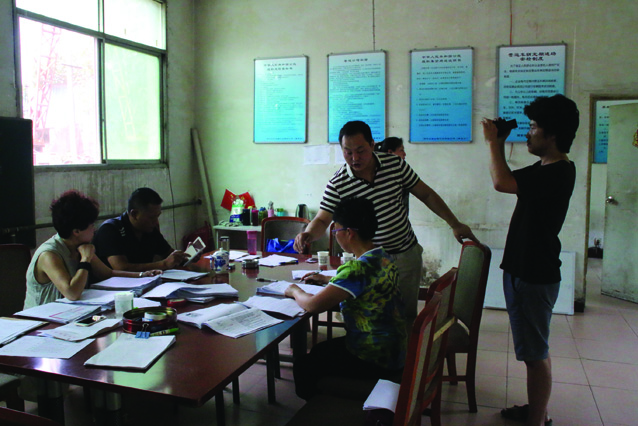
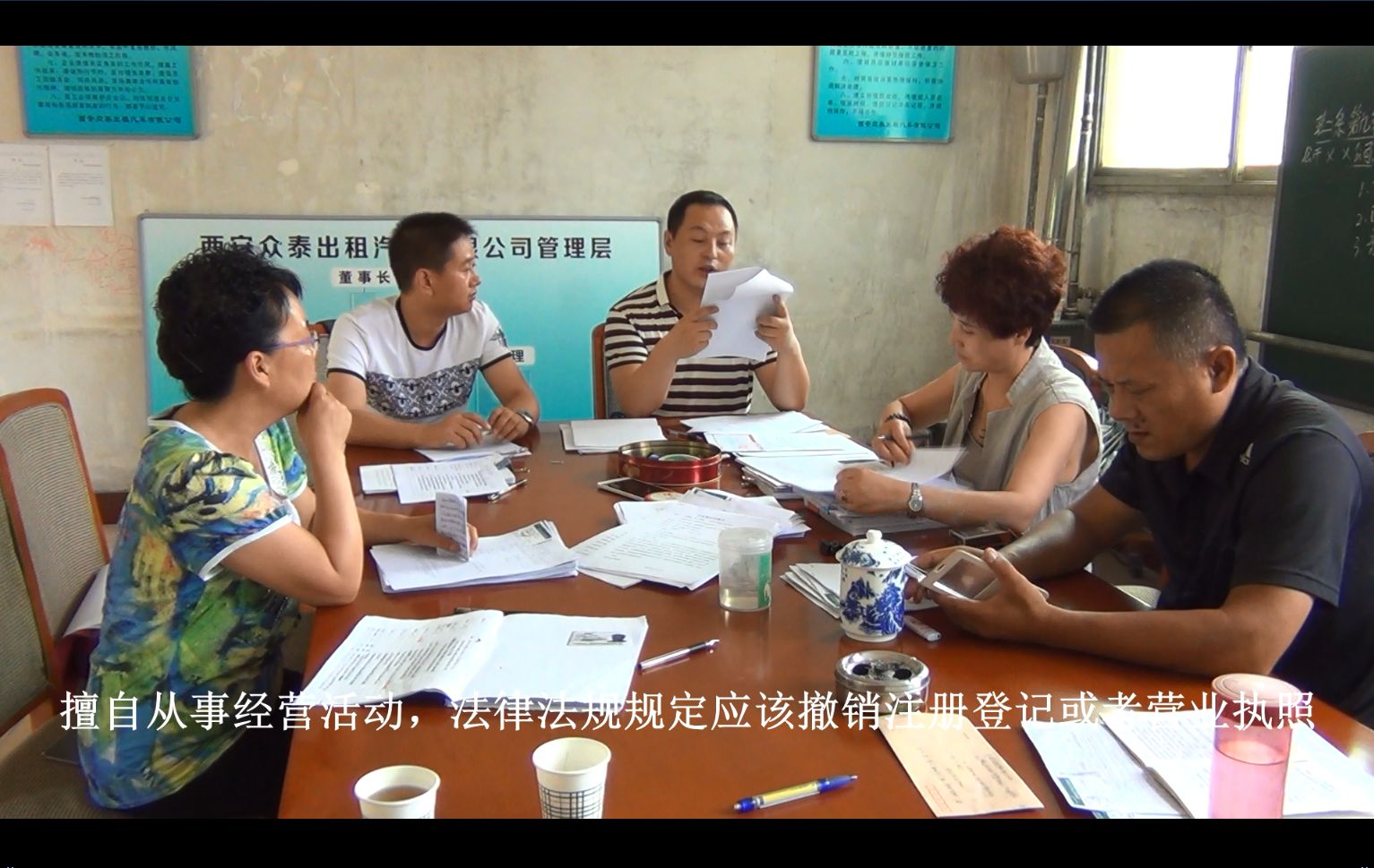
 图8—10 刘伟伟《众泰》 艺术项目 2015年
图8—10 刘伟伟《众泰》 艺术项目 2015年
作品说明:“众泰”是一个公司,也是出租车司机的一个自组织。西安有12000多辆出租车,3万多名司机。2012年开始,出租车司机维权事件不断发生,2015年初,西安95名出租车司机每人出资3万元,人人都做股东,组建了这个公司。虽然几经周折,拿到了工商执照,但到现在还没有“上路权”,无法正式运转。2015年,刘伟伟受西安美术馆邀请从重庆来到西安参加“青年艺术家计划”,没几天就注意到“西安的出租车维权轰轰烈烈”,很快,他就决定拍摄一部出租车司机维权的纪录片。拍摄花了两周的时间,刘伟伟带着自己随身的小DV,还有一部苹果手机,到郊区的二手车市场,到司机们栖身的出租屋,到法院门口,跟拍司机们学习法律、依法维权的过程。目前,他们的维权方式之一,是持续向政府部门、银行等寄送信息公开申请,目前已寄出1500多份。刘伟伟1988年出生于山东,毕业于四川美术学院,生活工作于重庆黄桷坪一带,他那些根本不指望卖出去的作品多数是艺术行动。
8. 众泰公司办公的地方,刘伟伟拍摄《众泰》纪录片的工作照。
9. 纪录片《众泰》截图。
10. 7月9日,纪录片《众泰》在西安美术馆放映,出租车司机们在美术馆观影。这是他们的维权之旅,也是第一次到美术馆的生活之旅。
Pictures 8 – 10
Liu Weiwei ZOTYE Art Project 2015
Introduction: ZOTYE is a company. It is a self-organized institutions of the taxi drivers. There are now over 12000 taxis and more than 30,000 taxi drivers in Xi’an, whose rights are often challenged. In the beginning of 2015, 95 Xi’an taxi drivers started ZOTYE, each of them contributing 30,000 RMB yuan and becoming the shareholders. Although these drivers acquired the business license through strenuous efforts, they are not yet allowed to go into operation. In 2015, Liu Weiwei, while in Chongqing, was invited by the Xi’an Art Museum to join the “Young Artists Program” in Xi’an. Several days after his arrival, Liu noticed the rigorous events of the taxi industry there. He immediately decided to shoot a documentary featuring the taxis driver’s story of right protection, which took Liu two weeks of work. He went to the driver’s rent place and the second-hand car market in the suburb areas with a walking DV and an iphone. He also went the court and recorded taxi drivers learning about law and protecting their own rights. One of their practices is to file applications to government agencies and banks, asking for information disclosure. A total 1500 pieces of applications were sent. Liu Weiwei was born in Shandong Province in 1988 and graduated from Sichuan College of Fine Art. He now works and lives in Huangjueping in Chongqing. He never thought of earning bills from his action arts.
8. Working Place of ZOTYE. Picture of Liu Weiwei Shooting the Documentary
9.Screenshot of the Documentary of ZOTYE
10. On July 9th, ZOTYE was shown in Xi’an Art Museum. The taxi drivers were watching the documentary in the museum. This is a part of their journey for right protection, and is also the first time they set foot on an art museum.

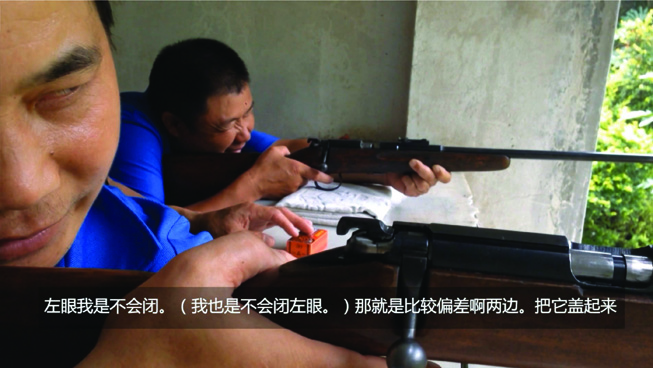
图11—12 刘伟伟《射击》 录像 23分21秒 2014年
作品说明:录像主要记录了刘伟伟在广州期间,找到一个冰箱厂的三个工人,在一段访谈结束后,邀请他们到郊区的打靶场练习射击的事情。
Picture 11 – 12
Liu Weiwei Shooting Video 23min. 21sec. 2014
Introduction: The major content of the video: Liu Weiwei interviewed three workers in a refrigerator manufacturing plant in Guangzhou and invited them to practice shooting in the suburb.
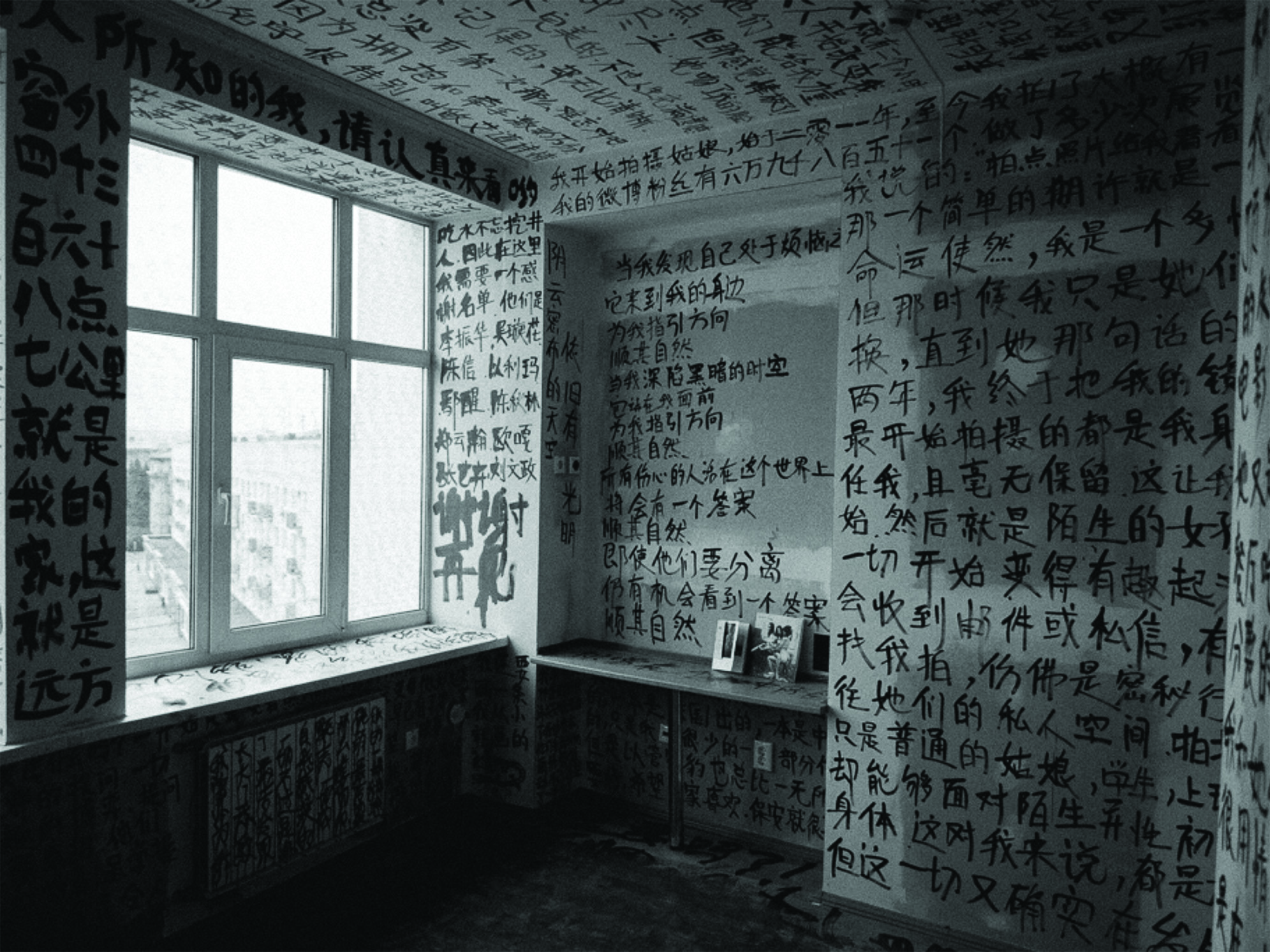 图13 九口走召《洞穴壁画》 空间装置 2015年
图13 九口走召《洞穴壁画》 空间装置 2015年
作品说明:九口走召将完成一个没有图像的大作,一个类似于山洞的文字游戏,这个类似于小说的墙面涂鸦,如同九口的摄影作品,都会引导观者进入其个人、私密的世界。九口的工作试图打破自身创作上的惯性。他——一个小说家,一个叙事者。希望将一个个人的故事,转化为空间的内部,并包容观者在其中。他更强调文本、文字和撰写的动作,关于意义和认知上自然出现的障碍,也就构成了阅读者在现场遭遇的非文本,而是图像。窗子上出现的俄文——诗,从窗子望出去的远方。——李振华
Picture 13
9 mouth Cave Paintings Space Installation 2015
Introduction: He will finish a masterpiece without images. A word game that is similar to caves. Like his photos works, this novel-like graffiti will lead the visitor into a personal and clandestine world. He tries to break away from the inertia during creations. In this work he became a novelist, or, a narrator who hopes to transform every individual story into the internal structure of spaces, which also includes the spectators. He pays much more attentions on words, texts and the movement of writing. The obstacle of meaning and recognition naturally constitute the non-text feature, which is images for the spectators on the spot. We see Russian on the window, these are poems, through which you can look into the distant places.( written by Li Zhenhua )
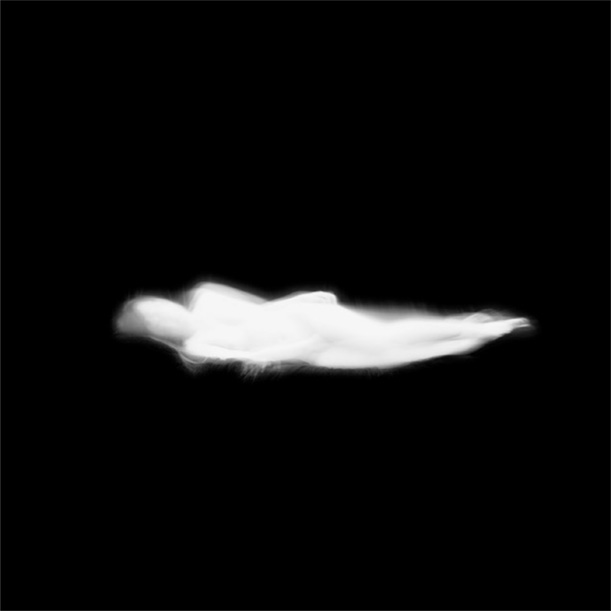
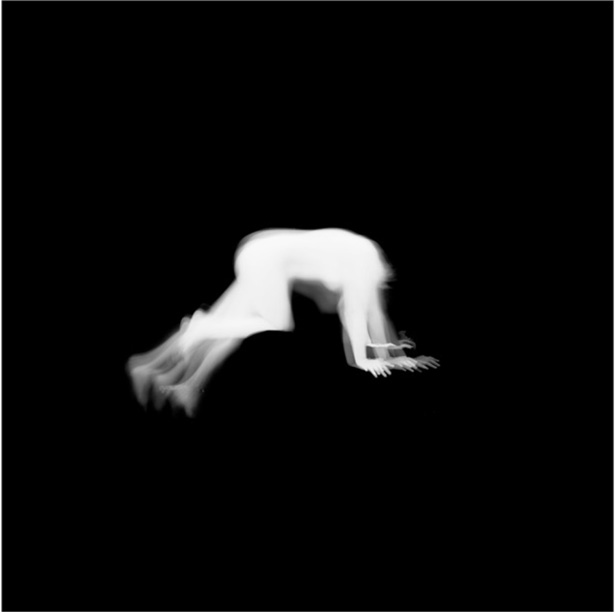 图14—16 九口走召《Masturbation》系列 图片 2014年
图14—16 九口走召《Masturbation》系列 图片 2014年
作品说明:女性一直是九口作品的主题和载体,他的照片既依附于她们,又凌驾于她们。这其中的关系近乎于最原始的崇拜和探索。《Masturbation》系列便是在这样的探索中将女性的力量诠释到极致。女性的自慰似乎不被看作男权社会中的典型案例。相对于被禁止,更多的是忽视。但无法忽视的一点是欲望,无论是谁都有享乐的责任。
九口走召,1988年生于中国荆州,现旅居北京。
把摄影作为自己的表达手段和艺术语言,用欲望作为动力记录当下女性自我意识的觉醒并与这个现实世界互动。除了摄影师亦有写作者及模特等多重身份,跨界于多个领域。
Pictures 14 – 16
9 mouth series of Masturbation Pictures 2014
Introduction: Woman is the subject and carrier of Jiukou’s works. His photos lives on women, yet it also overrides them. This subtle relation originates from the most primitive worship and explorations. The Masturbation Series unleash the power of women to the greatest extent during such explorations. Women’s masturbation is not regarded as a typical case in the patriarchal society. It is more ignored than being prohibited. However, one thing that cannot be forgot is that everyone has the right to seek pleasures.
Jiukou-Zouzhao, or known as 9 mouth, is born in Jinzhou in 1988. He now lives in Beijing.
Jiukou treats photography as the means of expression and the artistic language. He records the awakening of women’s self-conscious driven by lust and interacts with the real world. Jiukou is also known in many other fields apart from photography, writing and modeling.

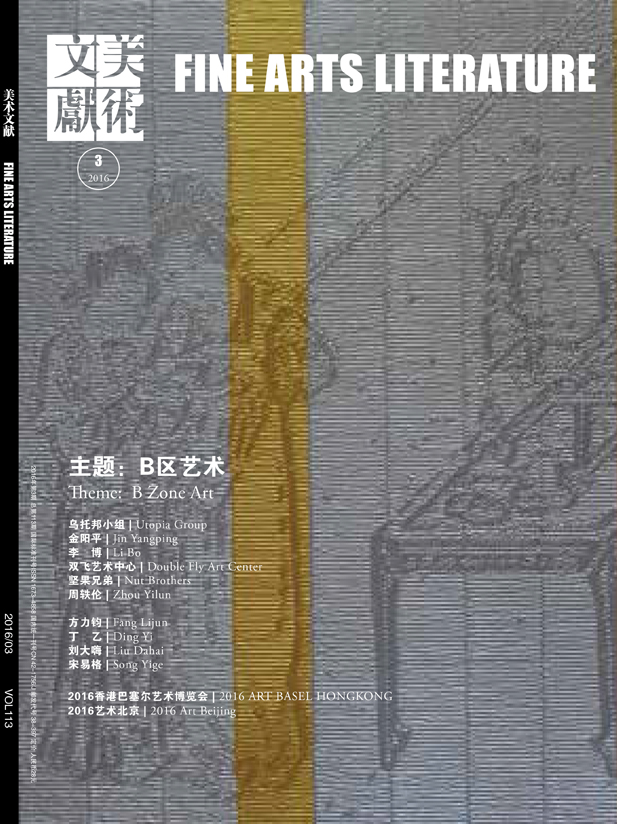
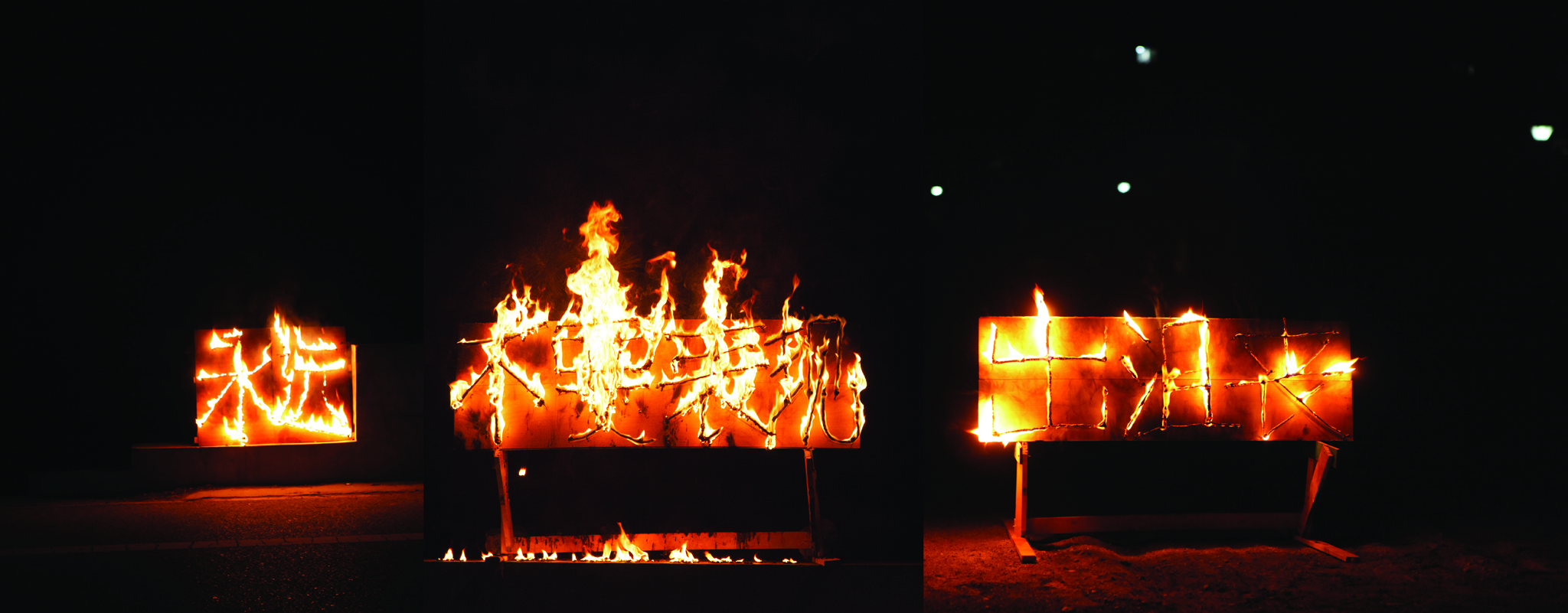 图1 邓大非《黑暗乌托邦2——永远不要表现出沮丧》截图 录像 2014年
图1 邓大非《黑暗乌托邦2——永远不要表现出沮丧》截图 录像 2014年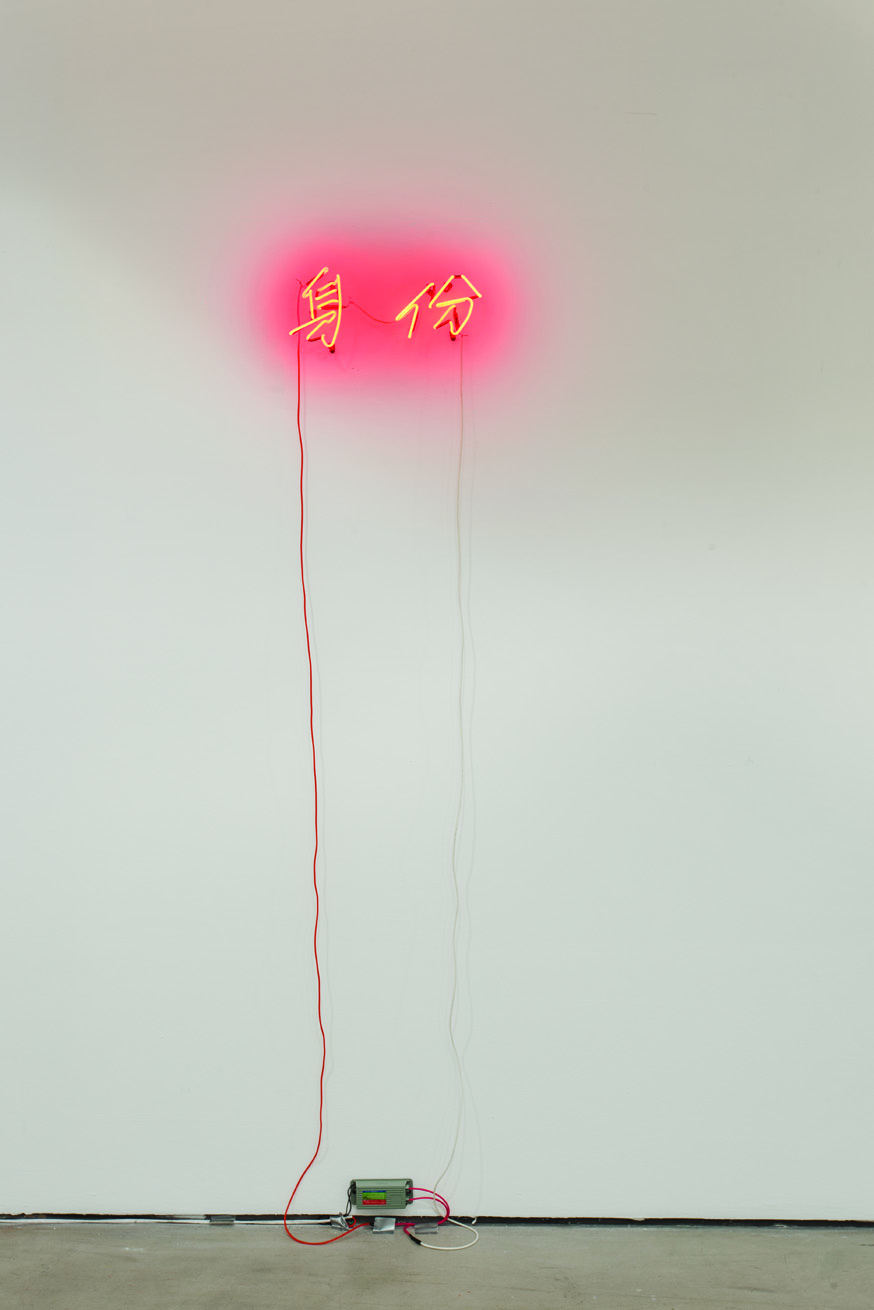 图2 金阳平《身份》 霓虹装置 尺寸可变 2015年
图2 金阳平《身份》 霓虹装置 尺寸可变 2015年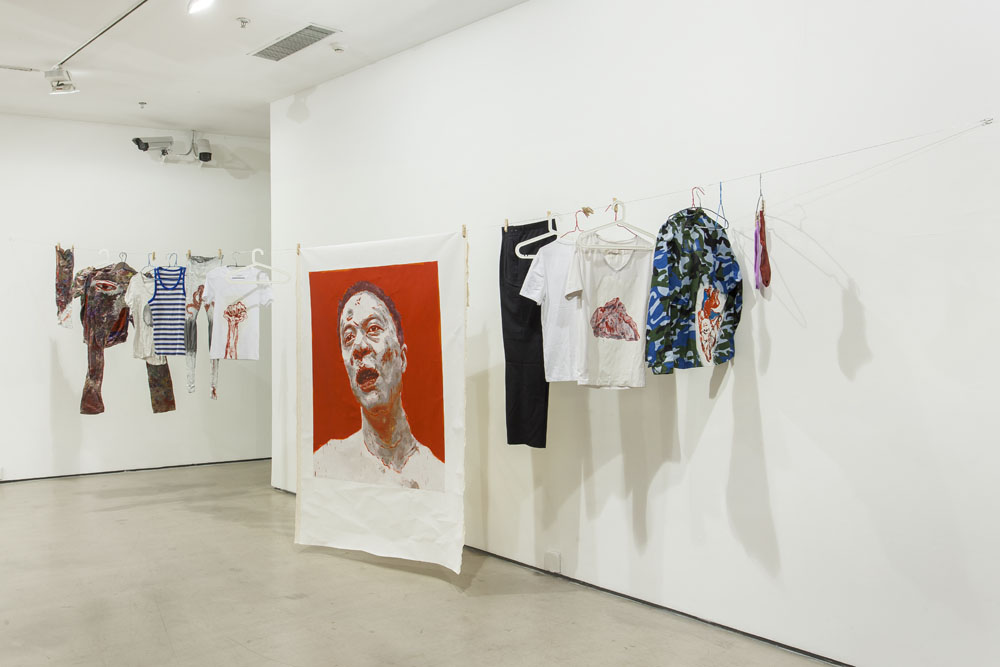 图3 金阳平《被打者3》展览现场 布面油画 135cm×165cm 2015年
图3 金阳平《被打者3》展览现场 布面油画 135cm×165cm 2015年